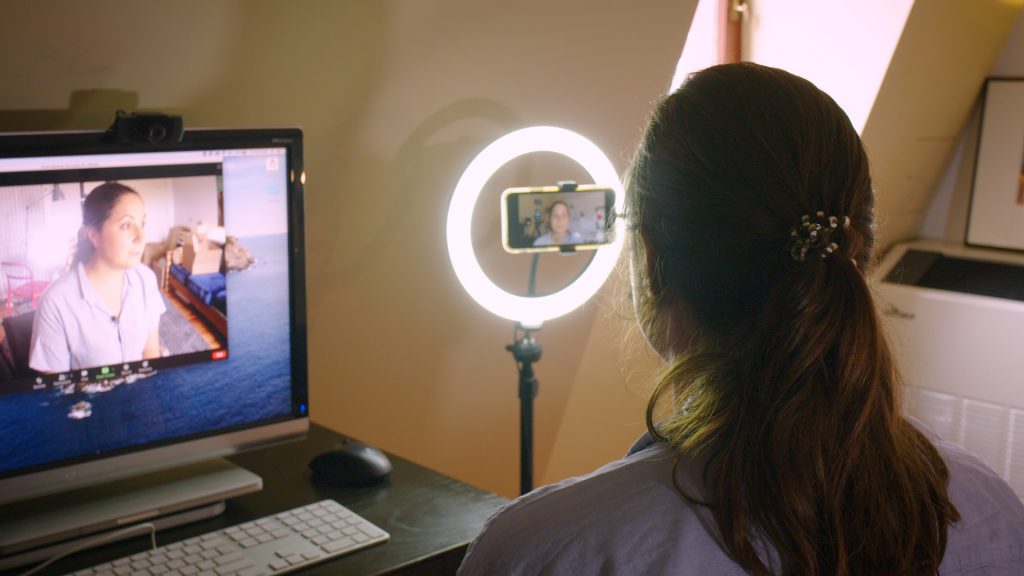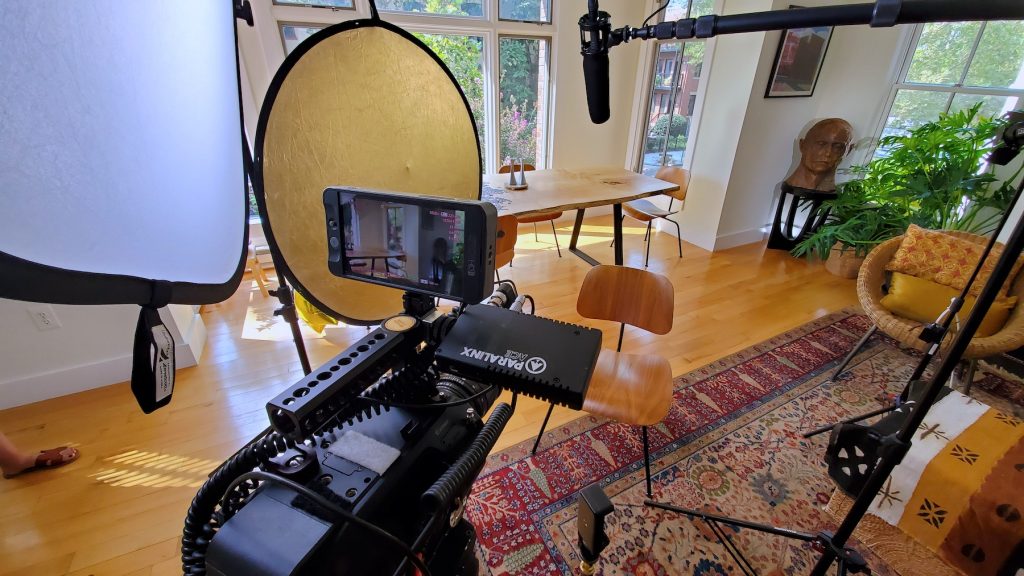Since COVID, we’ve worked hard to reimagine our work as storytellers by utilizing existing footage in fresh ways, creating animated stories and asking subjects to record themselves remotely. These approaches were drawn from early experiences pivoting our content creation during the pandemic. Since then, the country has reopened and we now understand more about how to capture content safely in-person and effectively remotely. Below are the two solutions we’re offering our clients for capturing interview footage, and some tips for accomplishing them:
Remote Filming Kits

We recognized early on in the pandemic that the quality of remotely recorded interview footage would be better if we asked subjects to record using their smartphone camera while we simultaneously interviewed them on zoom using their computer. But we realized that efforts to use window light, prop the camera eye-level using books and relying on the smartphone’s internal microphone were insufficient. So we developed remote filming kits that we ship to subjects, including a simple ring-light/tripod/phone holder and smartphone microphone. We also developed the strategies below:
- Provide SIMPLE instructions: In our early remote filming efforts, we sent subjects detailed written instructions with diagrams on how to light the interview, improve the settings on their camera, identify a good location. We quickly realized that few people were reading the instructions and if they were, they didn’t totally absorb them. As a result, we were eating up much of the already padded interview time to trouble-shoot lots of issues. So we developed a 90 second video explainer focused on settings and set-up using the kit and how they will need two devices (a computer for zoom and a smartphone for recording). The subjects can watch by using a QR code on the box or through a video link that we send them, and the visual format of video helped to convey the instructions more effectively. We decided to reserve the location selection and lighting tweaks for the zoom sessions as we could best direct those nuances over a video call.
- Use Video Chat for Location Scouting and Framing: We quickly realized that the subjects were not very good judges of what looks good for an interview, despite our written instructions. So we dedicate time in the very beginning of the zoom session to direct the subject on where to place the tripod, how to adjust the lighting, and frame the camera. It works best if we use video chat via Facetime or Whatsapp on our phones so we can see exactly what their phone cameras will be recording and can make adjustments. After we set “the look”, we hang up the video call so they can use the phone to record (you can’t do both simultaneously on the same device) and then use their nearby computer to conduct the interview over zoom.
- Consider Additional Shots & Provide Example Footage: We recently worked with a client looking to document a virtual fellowship training. In addition to using interviews and recorded zoom sessions, we asked the participants to use the filming kit to film themselves engaging in the virtual activities. We selected a few shots that we thought would be helpful (opening a laptop, an over-the-shoulder shot, a wide-angle) that provided additional footage to cut together. We are now working on a piece that may incorporate “slofies” or slo-motion selfies, accomplished easily on the iphone 11 and with a little more creativity with other smartphone models.
- Create a dropbox link: We send subjects a dropbox link that they can open directly on their phone and upload the files directly from their photo library so little to no tech knowledge is needed.
- Include a return label: We include a return label inside the remote filming kit package, so that subjects can easily ship them back to us in the same box.
In-Person Filming With Safeguards

While remote filming kits are a great option for producing multiple video interviews in varying locations safely, there are limitations even with the additional production value added by the equipment. So we are offering an in-person filming package and crew, but with the following safeguards that prevent people from sharing an indoor space for a prolonged time while speaking, with the subject not wearing a mask. Here are the ways we pull it off:
- Crew Wears N95 masks: We use N95 masks when filming in-person indoors. In our everyday lives, we wear cloth masks. But the N95s provide a much higher level of safety for the crew and subjects, both during setup when the subject is usually in another room, and during the interview when they aren’t wearing a mask.
- Keep Distant & Ventilate: The best ways to keep our crew distant from our subjects is to have them set-up the camera and lights while the subject is waiting in another room. Then when the set-up is ready and the subject arrives, the crew departs the room to monitor the camera remotely. There is some limited cross-over and in-person communication for which distance and masks work well. An extra precaution is to ventilate the space by cracking open a window, whenever possible.
- Monitor the Interview Wirelessly from Another Room: Using a wireless monitor, our crew is able to monitor the image and sound from the camera without being in the same room as the interview subject while they are speaking. Depending on the location, the crew can easily be 20-30ft away or more.
- Conduct the interview remotely: By placing a smartphone or ipad below the camera lens, we are able to have our producer conduct the interview remotely, and even have clients listen in and add questions. Each are asked to mute themselves while the subject answers questions so the sound isn’t picked up on the microphone.